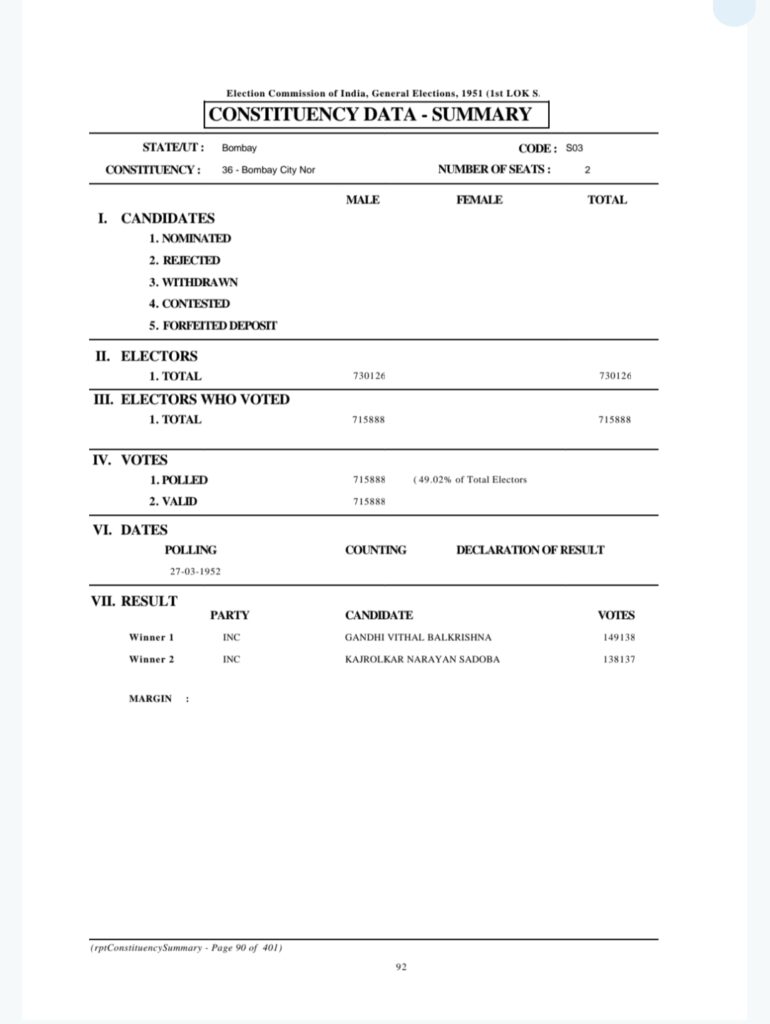X: @prashanthamine
Mumbai: Dr Bhimrao Ramji Ambedkar’s decision to resign from the union cabinet on September 27, 1951, as India’s first union Law minister was borne out of the stalling of the passage of the Hindu Code Bill. His ideological clash with the Congress later led to his two back-to-back defeats in the Lok Sabha elections of 1951-52. In both the elections he had to endure bitter defeats at the hands of his own contemporaries, from men whom he knew very well.
In the first instance it was in the 1951-52 First Lok Sabha elections from the then 36 Bombay City North, a dual member constituency where Dr B R Ambedkar lost to his one-time Personal Assistant, a Congress rival, Narayan Sadoba Kajrolkar by a margin of 14,561 votes.
In the second instance, it was in the Lok Sabha by-election to the then 18 Bhandara Lok Sabha constituency, another dual member constituency, held that very same year. Dr B R Ambedkar this time lost to Ashok Ranjitram Mehta (M A Ranjitram) of the Praja Socialist Party (PSP) by a margin of 17,153 votes.
Very few details are available in the archives of the Election Commission of India (ECI) of the country’s First Lok Sabha elections of 1951-52. Except for the fact that the exercise for holding the First Lok Sabha elections began in July 1948 with a public announcement for voter enumeration. It took almost four years and three months for the government to put the ECI in place, enact necessary laws and put the poll machinery in place.


It is altogether a different matter that it took close to four months for the First Lok Sabha elections to be held. The First Lok Sabha elections were held between October 25, 1951 to February 21, 1952.


Given the surcharged atmosphere then in the country which had guaranteed universal adult suffrage to all its citizens via Article 326 in 1950 itself, who would not have wanted to be in the elected First Lok Sabha of 1952?
The Report of the First Lok Sabha election itself was published as late as 1955 and reprinted in January 2020. The complete details of the results are not available, though the bare details do tell a story, though not the politics behind what led to the architect of our Constitution to resign in anguish.
In order to give adequate due representation to the Schedule Castes (SCs) and Schedule Tribes (STs) depending upon their concentration of population in some States and constituencies, there were some dual member constituencies introduced. Therein one of the two constituencies was reserved for SCs or STs candidates depending upon their population.
Dr Bhimrao Ramji Ambedkar was amongst the eight contesting candidates who contested from the then 36 Bombay City North Lok Sabha constituency.
For the first of the dual member seats, the contest was between Vithal Balkrishna Gandhi of the Indian National Congress (INC) / Congress and Ashok Ranjitram Mehta of the Socialist Party (SP).
Ashok Ranjitram Mehta was the founder member of the Socialist Party (SP) and later on the Kisan Mazdoor Praja Party (KMPP). The Socialist Party was later merged with the Praja Socialist Party (PSP). Mehta who was later expelled from the SP, later joined the Congress and contested the First Lok Sabha elections in 1952 on a Congress ticket.
For the second dual member seat, the contest was between Dr B R Ambedkar’s one-time Personal Assistant, Narayan Sadoba Kajrolkar who contested on a Congress ticket. Dr B R Ambedkar had then contested the election as a Schedule Caste Federation (SCF) candidate.
As per the sketchy details available, the electoral population was 7,30,126 out of which 7,15,888 were eligible voters, who actually voted in those elections then. The final polling percentage was 49.02%.
The final result of the then 36 Bombay City North Lok Sabha constituency was as follows:
First seat:
Vithal Balkrishna Gandhi – INC – votes polled – 1,49,138 – vote share 20.83% (Winner). Margin of victory – 9,397 votes.
Ashok Ranjitram Mehta – SP – 1,39,741 votes – 19.52%. (Lost).
Second seat:
Narayan Sadoba Kajrolkar – INC – 1,38,37 votes – 19.30% (Winner). Margin of victory – 14,576 votes.
Dr Bhimrao Ramji Ambedkar – SCF – 1,23,576 votes – 17.26%. (Lost).
Shripad Amrut Dange – Communist Party of India (CPI) – 96,755 votes – 13.52%. (Lost).
Gopal Vinayak Deshmukh – Independent – 40,786 votes – 5.70%. (Lost).
Keshav Balkrishna Joshi – RRP – 15,195 votes – 2.12%. (Lost).
Nilkanth Baburao Parulekar – Independent – 12,560 votes – 1.75%. (Lost).
Not disheartened by the electoral loss, electoral opportunity once again presented itself before Dr B R Ambedkar. That same year, by-election took place for the 18 Bhandara Lok Sabha constituency which was then part of the state of Madhya Pradesh. Another dual member constituency.
The final result of the then 18 Bhandara Lok Sabha constituency was as follows:
First seat:
Ashok Ranjitram Mehta – PSP – 1,49,636 votes – Winner.
A B Ramji – SCF – 1,32,483 votes – Lost.
Margin of victory for Ashok Ranjitram Mehta (PSP) was 17,153 votes.
Second seat:
ST B A Bhaorao – INC (Congress) – 84,458 votes – Winner.
A H Damaji – SCF – 58,504 votes – Lost.
Margin of victory for ST B A Bhaorao (Congress) was 25,954 votes.
It is widely claimed that Dr B R Ambedkar was elected to the Rajya Sabha from the then state of Bombay in March 1952, of which sadly no authentic records are available.






